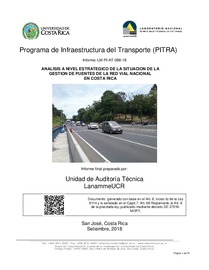| dc.contributor.author | Sequeira Rojas, Wendy | |
| dc.contributor.author | Loría Salazar, Luis Guillermo | |
| dc.contributor.author | Rodríguez Morera, José David | |
| dc.contributor.author | Fonseca Chaves, Francisco | |
| dc.contributor.author | Agüero Barrantes, Pablo | |
| dc.date.accessioned | 2019-01-23T14:52:29Z | |
| dc.date.available | 2019-01-23T14:52:29Z | |
| dc.date.issued | 2018-09 | |
| dc.identifier.uri | https://www.lanamme.ucr.ac.cr/repositorio/handle/50625112500/1418 | |
| dc.description | This audit report analyzed the bridge management topic in the National Road Network of Costa Rica (RVN). As a first point, the analysis of the trajectory that this subject has had is presented. Despite that Law 7798 (Creation of Road Authority Law -CONAVI-) since 1998, indicates that all investments must be based on a Road Asset Management System, two decades later, the Costa Rica lacks of an effective implementation of this system, either for pavements or for bridges. This has happened in spite of provisions of the General Comptroller of the Republic, recommendations of LanammeUCR and even consultancies contracted by the own Administration. It is evident in this sense, the absence of leadership in about this subject at the executive level in the Administration and it is recommended to take advantage of all the inputs already available in the country. It is recommended as well to develop a comprehensive strategy that finally delivers the implementation the asset management philosophy in CONAVI.
In order to know the maturity level of asset management processes in the case of bridges, a survey was applied based on the methodology of the Transportation Asset Management Guide of AASHTO (USA). This survey allows to know aspects related to policies, planning, programming and information systems. From the results obtained, it was determined that all the aforementioned categories are in the "Recognition" stage. This is the second level (on a scale of 5 levels: initial, recognition, structured, proficient and best practices). At the given level, there is recognition for the need to create basic databases and other initiatives, however, these rely on individual, not institutional efforts to move forward.
Finally, it the Institutional Five-Year Plan for Bridges and Structures of Major Drainage 2018-2022 and the Institutional Operational Plans of 2017 and 2018 of CONAVI were analyzed. In this matter, there are weaknesses in its conception about best management practices of assets, since there is no adequate strategy in the medium term or actions that consider the entire life cycle of the bridges.
Finally, an observation about inconsistencies in the sums of the budgets of the Five-Year Plan is also incorporated in order to draw attention to this difference. | es |
| dc.description.abstract | El presente informe de Auditoría Técnica analizó la gestión de puentes de la Red Vial Nacional de Costa Rica (RVN). Como primer punto, se presenta el análisis de la trayectoria que ha tenido el tema. A pesar de que la Ley 7798 de Creación del CONAVI (1998) indica que todas las inversiones deben basarse en un Sistema de Administración de Carreteras, dos décadas después, el país carece de una implementación efectiva de un sistema de gestión, sea para pavimentos o para puentes. Esto ha sucedido así a pesar de disposiciones de la Contraloría General de la República, recomendaciones técnicas del LanammeUCR e incluso consultorías contratadas por la Administración. Se evidencia en este sentido la ausencia de liderazgo en el tema de parte del nivel ejecutivo en la Administración y se recomienda aprovechar todos los insumos ya disponibles en el país, así como desarrollar una estrategia integral que consiga finalmente implementar la filosofía de gestión de activos en el CONAVI.
Para conocer el grado de madurez de la gestión de activos, en caso de los puentes de la RVN, se aplicó una encuesta basada en la metodología de la Guía de Gestión de Activos de Transporte de la organización AASHTO, de EEUU. Esta encuesta permite conocer aspectos relacionados con políticas, planificación, ejecución de programas (proyectos) y sistemas de análisis de información. De los resultados obtenidos se determinó que todas las categorías mencionadas, se encuentra en la etapa de "Reconocimiento". Este es el segundo nivel (en una escala de 5 niveles: inicial, reconocimiento, estructurado, competente y mejores prácticas). En el nivel determinado, existe un reconocimiento por la necesidad de crear bases de datos básicas y otras iniciativas, sin embargo, éstas recaen en esfuerzos individuales, no institucionales, para avanzar.
Por último, se analizaron el Plan Quinquenal Institucional Puentes y Estructuras de Drenaje Mayor, 2018-2022 y los Planes Operativos Institucionales del 2017 y del 2018 del CONAVI donde se evidencia que existen debilidades en cuanto a su concepción dentro de las mejores prácticas de la gestión de activos, ya que no se observa una estrategia adecuada a mediano plazo ni acciones que consideren todo el ciclo de vida de los puentes.
Finalmente, se incorpora también una observación sobre inconsistencias en las sumas de los presupuestos del Plan Quinquenal con el fin de llamar la atención sobre esta diferencia | es |
| dc.publisher | Laboratorio Nacional de Materiales y Modelos Estructurales (LanammeUCR) | es |
| dc.subject | PITRA, Gestión, Puentes, Activos | es |
| dc.subject | PITRA | |
| dc.subject | Unidad de Puentes | |
| dc.subject | Unidad Auditoria Técnica | |
| dc.title | Análisis a nivel estrategico de la situación de la gestión de puentes de la red vial nacional de Costa Rica | es |
| dc.title.alternative | LM-PI-AT-086-18 | es |
| dc.type | informe técnico | es |
| dc.description.procedence | UCR::Vicerrectoría de Investigación::Unidades de Investigación::Ingeniería::LanammeUCR | es |

